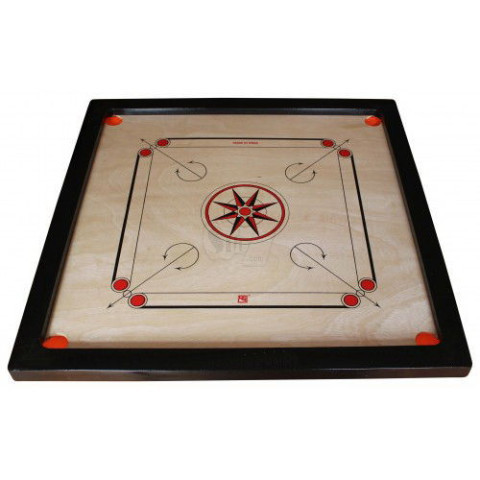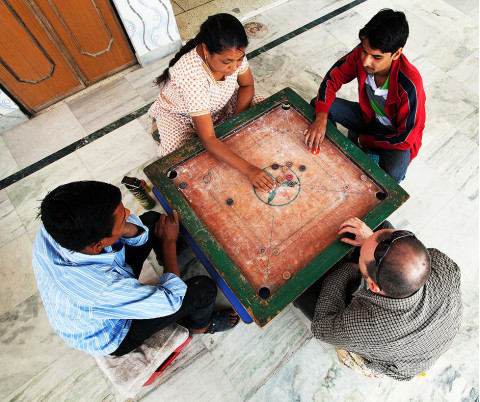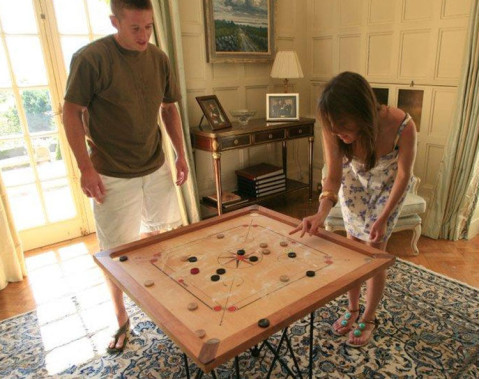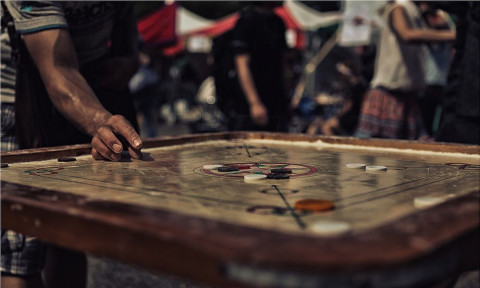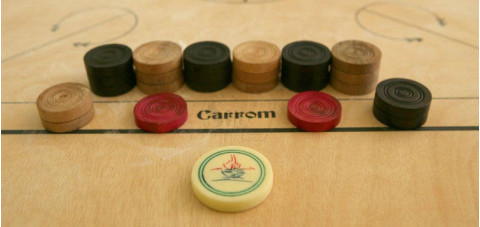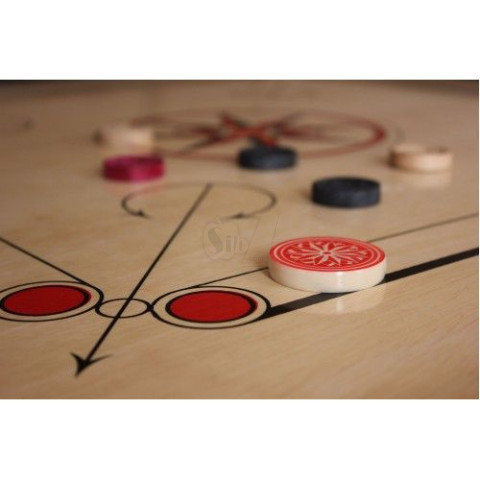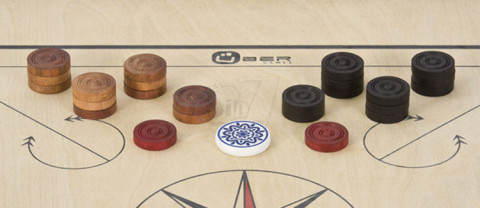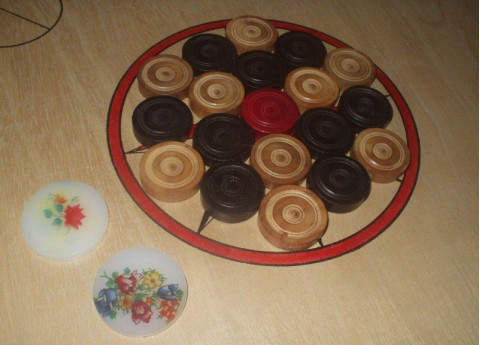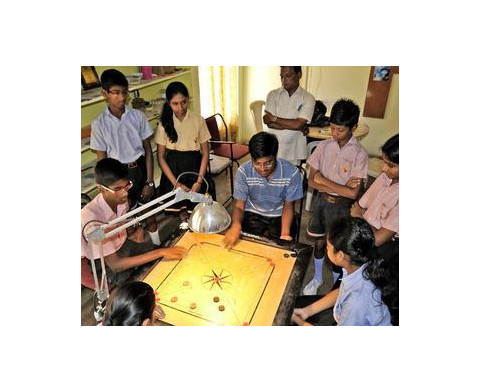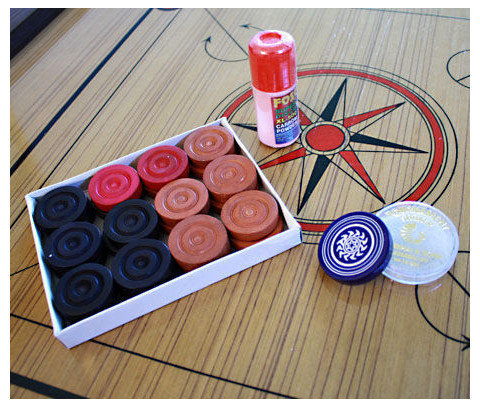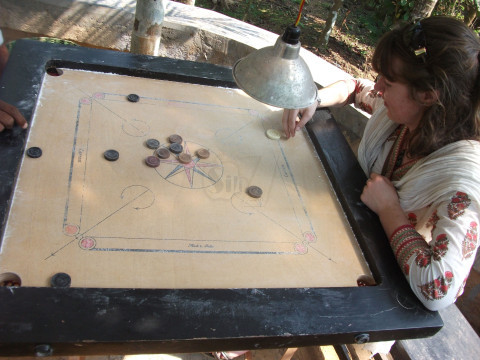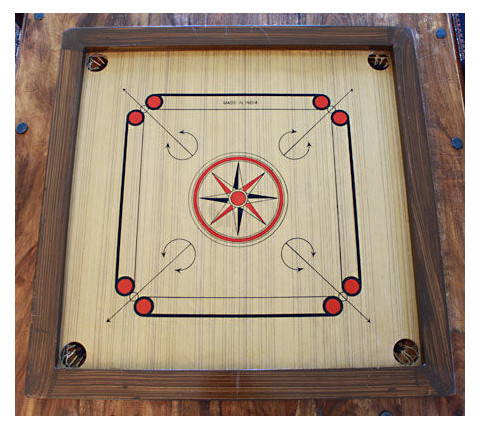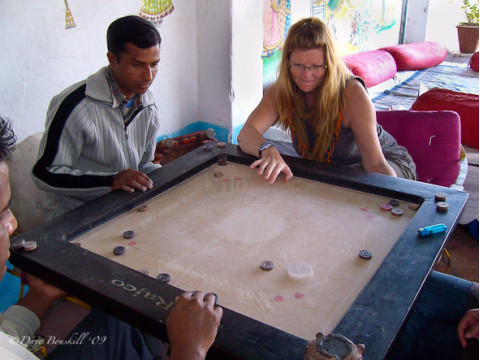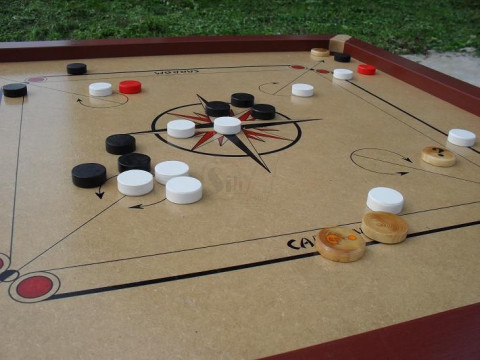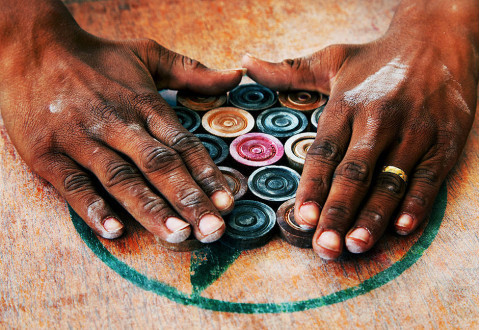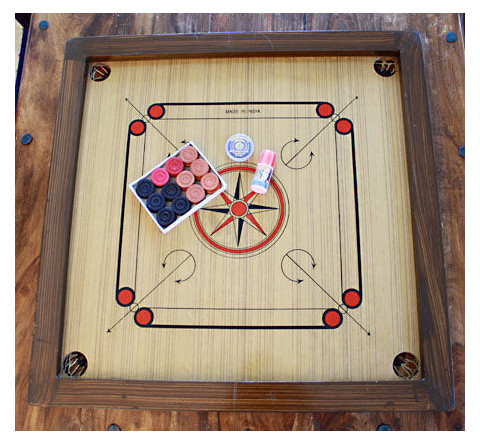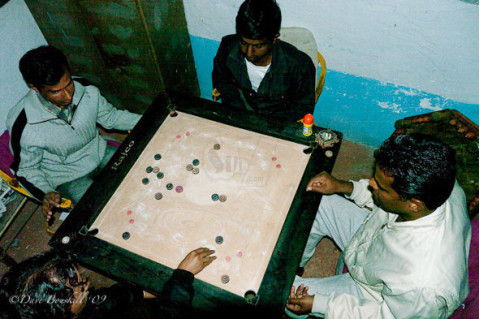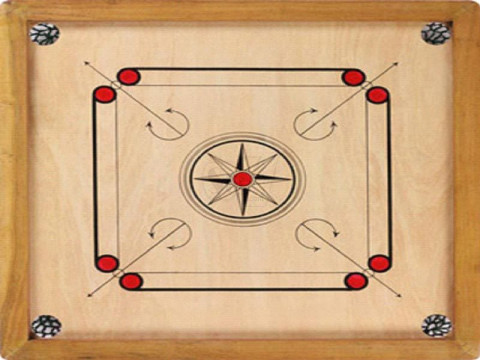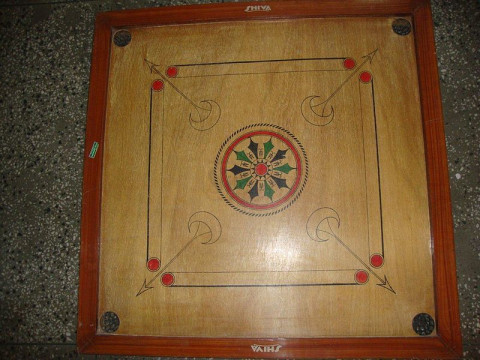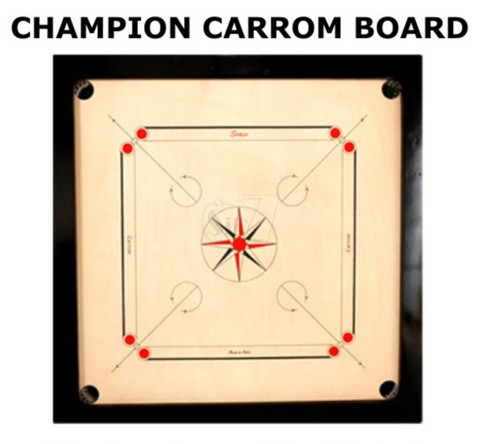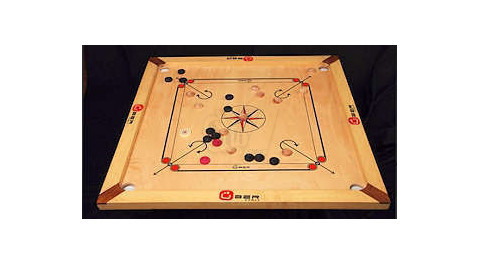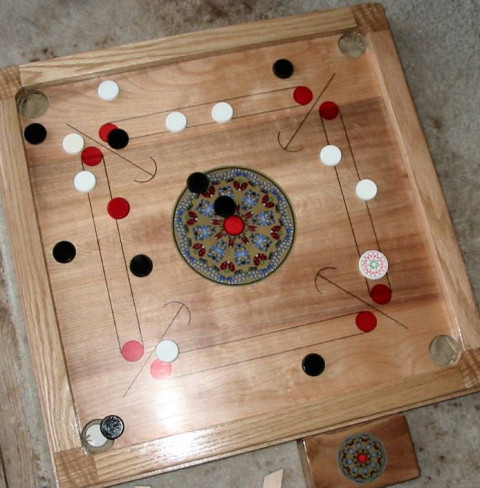جعفری از مشهد
Carrom or carroms is a family of tabletop games sharing a similarity in that their mechanics lie somewhere between billiards and table shuffleboard. The game has various other names around the world, including carrum, couronne, carum, karam, karom, karum, and finger billiards.
The origins of carrom are uncertain, although western sources suggest that the game is of Indian, Portuguese, or Burmese origin. Variations of the game played with a cue stick similar to those used in billiards-type games may have independently developed in several cases as a mixture of billiards and shuffleboard.
The game is very popular in India, and in Punjabi it is called fatta. Similar games are played throughout the world, and may or may not share common origins with carrom. In Denmark a similar game called bob is played with cues rather than fingers. There is a carrom-like game also played with cues in China.
Rules and regulations
International rules are promulgated by the India-based International Carrom Federation, the governing body of carrom. The organization also ranks players, sanctions tournaments and presents awards, and has many national affiliates such as the All-India Carrom Federation, Australian Carrom Federation, UK Carrom Association and US Carrom Association. There is a penalty a person has to pay if his striker goes in the hole. This term is referred to as deuce. The penalty is usually 10.
A Carrom Board
Carrom (also known as Karrom) is a "strike and pocket" table game of Eastern origin similar to billiards and table shuffleboard. It is found throughout the East under different names though most non-eastern people know it by the East Asian name of Carroms (or Karrom). It is very popular in Nepal, India, Pakistan, Bangladesh, Sri Lanka and surrounding areas. In South Asia, many clubs and cafés hold regular tournaments. Carrom is very commonly played within families and other functions. Different standards and rules exist in different areas. A popular variant of the game called Duboo is played mostly in Karachi the largest city of Pakistan.
Origins
The International Carrom Federation (ICF) was formed in the year 1988 in the city of Chennai, India. The formal rules for the Indian version of the game were published in 1988. In the same year the ICF officially codified the rules. The game is very popular throughout South Asia mainly India, Pakistan, Bangladesh, Sri Lanka, Nepal etc. and has gained some popularity in Europe and the United States where it has been introduced by the Indian diaspora. The United States Carrom Association reports on competitions in the USA and Canada and has a player ranking list as of the last tournament.
The board and pieces can be bought in Europe or the USA and are usually imported from India. The most expensive boards are made to a high standard with high quality wood and decorations though cheaper boards are available. Some of the largest exporters of carrom boards are in India, e.g. Precise, Surco, Syndicate Sports and Paul Traders.
Objective of play
The objective of play is to use a striker disk with a flick of the finger to make contact with and move lighter object disks called carrom men, which are thus propelled into one of four corner pockets.
The aim of the game is to pot (or pocket) one's nine carrom men and the Queen before your opponent.
Equipment
The game is usually played on a board made of plywood. The dimensions of the standardized game is a 29 inches (74 cm) square playing surface on a board of lacquered plywood. The edges of the playing surface are bounded by bumpers of wood, and the underside of each pocket is covered by a net which is 10 cm2 or larger.
Carrom men
Carrom men and two strikers, arranged at the start of a game
Carrom is played using small disks of Wood or Plastic known as carrom men, sometimes abbreviated c/m. The pieces are also known as seed, coin or Pawn puck. Carrom men are designed to slide when struck and are made with a smooth surface that allows contact with the board when the pieces are laid flat. They are struck by a Striker of standard specification which is larger and heavier. Carrom follows similar "strike and pocket" games, like pool, with its use of rebounds, angles and obstruction of opponent's pieces.
A carrom set contains 19 pieces (striker not included) in three distinct colors. Two colors to represent the player's pieces and one color for the Queen. The usual colors are white (or unstained) and black for the player's and red for the queen.
ICF approved pieces must have a diameter of no more than 3.18 cm and no less than 3.02 cm. The pieces must be at least 7 mm and at most 9 mm thick. The pieces have a plain, rounded edge. The mass of the pieces is within 5 g and 5.5 g.
Strikers
Striker pieces are used to push the carrom men and the queen across the board to the pockets.
The Queen
The red disk is called the queen. The queen is the most powerful carrom piece. During board setup, it is placed at the center of the circle. In accordance with the ICF rules, pocketing the queen adds 3 points to the player's total score. The dimensions of the queen must be the same as those of other carrom men.
The player must pocket the queen and subsequently pocket a carrom man of the player's own color. This is termed covering the queen. If, by mistake, a player puts the carrom man of the opposite team in the pocket after "pocketing" the queen, then the player owes the queen to defending player, or a due is fined. (Rules vary on this penalty.)
If the player fails to pocket a subsequent carrom man, the queen is replaced at the center of the circle.
If the player pockets his or his opponent's last carrom man before pocketing the queen, the carrom man is placed back on the board
If a player puts the queen and a carrom man of the player's own color in the pocket with one use of the striker, the queen is automatically covered, no matter which went first.
Powder
Fine-grained powder is used on the board to enable the pieces to slide easily. Boric acid powder is the most commonly used for this purpose. Boric acid has recently been reclassified by the EU as 'Toxic for reproduction'
In the UK, many players use a version of anti-set-off spray powder from the printing industry which has specific electrostatic properties with particles of 50 micrometers in diameter. The powder is made from pure, food-grade vegetable starch.
Standardized rules and regulations
The toss
Order of play is determined by the process of "calling the carrom men" or "the toss". Before commencing each match, an umpire hides one black carrom in one hand and one white carrom man in the other hand. The players guess which color carrom men is being held in each hand. The player who guesses correctly wins the toss.
The winner of the toss strikes first, which is called the opening break. The winner of the toss has the option to change sides from white to black and give up the opening break. The winner of the toss may not pass this decision to the other player. If the winner of the toss chooses to change sides then the loser must strike first.
The player taking the first shot (or break) gets to play white carrom men. The opponent plays black.
Shooting
The aim of the game is to pot (or pocket) one's nine carrom men and the queen before your opponent does. A successful pot entitles the player to shoot again. This means that, like pool and snooker, a player may pot all his pieces and cover the queen from the start of the game without the opponent being given the chance to shoot.
Any player pocketing the queen is required to cover it by immediately pocketing one of their carrom man on the entitlement shot. If after potting the queen the player fails to cover it then the queen is returned to the center of the table. It is illegal to pot the Queen after the last piece since the queen must always be covered.
Thumbing is allowed by International Carrom Federation which allows the player to shoot with any finger including the thumb (known as "thumbing" or a "thumb shot" or a "thumb hit").
Crossing the diagonal lines on the board by coming in touch with it, or pocketing the striker is a foul. A player needs to ensure that his striking hand does not infringe/cross the diagonal lines aerially/physically. A player committing a foul must return one carrom man that was already pocketed.
If a player pockets his striker, he has to pay a penalty. This penalty is usually 10 points.
Rule # 1: Family-Point Carrom game
Simple-Point Carrom (Family-Point Carrom) is a variant that is very popular with young and old, or when playing with an odd number of players.Players are allowed to pocket carrom men of any color. A majority of people play by the following simple rules:
The objective of play is to use a striker disk with a flick of the finger to make contact with and move a carrom man (lighter object coin) into one of four corner pockets.
Typically Black carrom man (coin) gives 5 points, white/khaki color (or non-black) gives 10 points and Red color (queen) gives 25 points to the player.
Pocketing the queen must be followed by pocketing another carrom man (coin) on the same strike. To get Red color (queen) points, one needs to put a carrom man of any color in the pocket after queen. If the player fails to cover the queen in this fashion, the queen is put back in the center of the board.
The player or team will win if they have the most points.
Sets of 1, 3 or 5 are common.
With points system, if one team/player gets queen points early in the game, the opponent still has a good chance to win by earning more points.
This style of play is widely accepted in many areas of South Asia and quite popular with housewives.
Common Rule # 2: Point Carrom game
Point Carrom is a variant that is popular with children or an odd number of players. Game play is as described above with a variation. Players are allowed to pocket carrom men of any color.
Carrom men of black color are assigned 1 point and white color are also assigned 1 points.
The red queen is assigned 3 points.
Pocketing the queen must be followed by pocketing another carrom man on the same or subsequent strike.
The first player to reach 25 points is declared the winner.
If no player reaches 25 points, the player with the highest points is declared the winner. If the scores are tied, a tie-breaker must be played. Players who are tied (in points) select a color. They are allowed to pocket carrom men of an alternate color only on rebound.
This style of play is common in some areas of East Asia.
Common Rule #3: Total-Point Carrom game
Total point carrom is a variant of point carrom, in which the black carrom men are worth 5 points and the white ones are worth 10 points.
The red queen is assigned 50 points and must have a subsequent carrom men pocketed after it.
To win, a player must receive all the carrom men on the board.
After the first round the player or team with the lowest score puts all their carrom men in the center.
The others must match this score in the center and the players play for the carrom men in the center.
They repeat this until one team or player has all the carrom men.
This style of play is widely accepted in many areas of India and Pakistani.
Common Rule #4: Professional Carrom game
Each team or player assigned a color coin and can only pocket that color coin.
Pocketing the queen must be followed by pocketing another coin on the same strike.
The red 'queen,' can be pocketed at any time after sinking your first piece but must be sunk before your last one. After pocketing the queen, you must sink one of your carrom men, thereby 'covering' it, into any pocket in the next shot, or she is returned to the center spot.
Once the queen is covered, whoever clears all their carrom men first wins the 'board'.
Queen & cover can't be on same pocket.
The winner of a board collects one point for each of the opponent's carrom men left at the finish and three points for the queen if covered by the winner (if covered by the loser, no-one gets those points). No more points are collected for the queen after your score reaches 21.
A game consists of 29 points.
When placing the striker on the board to shoot, it must touch both 'base lines', either covering the end circle completely, or not touching it at all. The striker may not touch the diagonal arrow line.
Shooting styles are very personal - whichever 'grip' works for you is fine as long as you 'flick' the striker and don't push it. Generally, it's best to orient your body in order to see the line of your aim while shooting comfortably; you may not move or leave your chair.
For forward shots, you can use your index finger, middle finger, or even the 'scissors' shot. Before shooting, try touching the striker with your fingernail, to be sure that its really on line. This will improve your accuracy and prevent you from hurting your finger.
Carrom men can be struck directly only if they are not touching the player’s baseline or situated behind the base line. If the carrom man is behind the baseline, the player must hit the carrom man by rebounding the carrom striker off any side of the carrom board or any other carrom piece on the board
Sinking the striker costs you one piece and your turn. But, if you sink a piece in the same shot, then two come up and you do not shoot again.
After sinking the striker, your opponent places the due piece(s) within the center circle. If you haven't sunk one yet, you owe one.
If while shooting for the queen you also sink one of your carrom men in the same shot, the queen is automatically covered, no matter which went first.
If a piece jumps off the board, it is placed on the center spot. If pieces land on end or are overlapping, they are left that way.
If the center spot is partially covered when replacing the queen or a jumped piece, the piece should cover as much red as possible. If totally covered, the piece is placed opposite the next player behind the red spot.
If you touch your last piece directly before the queen, you have to pay a penalty.
If you sink your opponent's piece, you lose your turn. If you sink their last piece, keep the coin again and play
If you sink your last piece before the queen, you lose the board and three points.
If the striker does not leave both lines, go again. You get three tries to break before losing your turn.
These rules are mostly played in UK and India.
Board variations
Carrom boards are available in various board sizes and corner pocket sizes. There are smaller boards and boards with larger pockets. Boards with larger pockets are used by beginners for easier game play. On traditional carrom boards, the corner pockets are only slightly larger than the carrom men, but smaller than the striker. On boards with larger pockets, it is possible to pocket the striker, resulting in a "scratch shot" as in Pool. This results in a "due." On a "due", the player has to replace one previously pocketed carrom man on the board. When the scores are tied at a point in the carrom game, a tie-breaker is played. The team which has pocketed the "queen" does not gain any advantage. The Standardized Association and Federation size is 29" x 29" Play Surface with borders between 2" each to 4" each. Other play areas are not used in Tournaments and Competitions.
Japanese carrom
Carrom was introduced to Japan in the early 20th century. Carrom became popular as Tokyo-ban ("fight ball board" or "throw ball board") and it fell in popularity in the Showa period. However, carrom is still popular in Hikone, Shiga.
In popular culture
In 2010 a Hindi "Bollywood" film titled Striker was released. The movie focuses on carrom hustlers in Mumbai in the 1980s.
The Hindi film Ankush showed the ability of carrom to help four unemployed youth escape the painful realities of life.
A Tamil film called Vilayaada Vaa released in 2012 was also focused on carrom board.
Indian movies Munnabhai MBBS and its Telugu remake - Shankar Dada MBBS, Tamil remake - Vasool Raja MBBS, Kannada remake - Uppi Dada M.B.B.S. also features a movie scene with Munnabhai playing carrom to heal an elderly friend with his friends and an Orange Juice
Carrom is believed to have originated in India around a hundred years ago. No one really knows who invented it but it became very popular and is now one of the most widely played games throughout southern Asia.
The equipment used to play carrom consists of a board with four holes or pockets, nine white pieces and nine black pieces called the carrom-men, and a red or patterned piece is known as the queen. The pieces are made of wood. A striker is used to knock the carrom-men into the pockets. This is usually made of plastic but in the past would have been made from ivory or bone. To allow the pieces to glide around the table better and so speed up the game, many players first cover the board with boric acid.
Carrom is a game for two or four players. Players sit opposite each another and take turns trying to slide the carrom-men into the pockets at each corner using the striker. The object of the game is to clear all your carrom-men before your opponent. Before you pocket your last carrom-man, one player must pocket the queen and then pocket another carom-man directly after. If you fail to do this the queen is replaced on the table.
The first international carrom tournament took place in 1989 with India, Sri Lanka, the Maldives, Germany, Switzerland and Holland competing for a silver cup.
Carrom is a family of table board games with gameplay that lies somewhere between billiards and table shuffleboard. Carrom is most easily described as "finger pool". On a 29" x 29" wooden board, players flick a large weighted disc (the striker) at smaller wooden discs (the carrom-men). The goal is to sink your 9 carrom-men (black or white), as well as the red Queen, in the four corner pockets. The first player or team to accomplish this collects points for the round (commonly called a "board"). A standard game of Carrom continues until one player has 25 points or 8 boards have been completed. Carrom is known by many names around the world. Mango Board with Rosewood details - 33" x 33" (29" x 29" internal playing area) x 1.5" thick. Comes with game board, rules, and all pieces needed to play.
What is Carrom
Carrom is a game that is played on a smooth wooden square table. It uses flat round carrom balls (shaped like checker pieces) to play with. Each player has 9 pieces that they need to sink into the pocket. There are 9 black 9 white and 1 red carrom ball.
You try to put each piece into the corner pockets with the larger white ball called the striker. The first person to sink all 9 of their color wins.
The Extra Piece
The red ball can be sunk at any time and it gives you 5 extra points. However, when you sink the red ball, you must immediately sink your color otherwise the red ball comes back out to be put back in play.
The game goes to 29. After each round, the person that wins gets points by the amount of their opponents balls left on the table. If they sunk the red ball also, they would receive and extra 5 points.
It is a popular game and there are even tournaments around India.
Deb’s Turn
I tried to give it a go and I have to say, it looks easier than it is. It takes some skill and practice.
They powdered down the table with Carrom Powder (it is like a talcum powder) to help the pieces move smoothly across the wood.
I was giving the honor of breaking the formation. It is just like breaking the balls in a game of pool. I did a weak break but luckily my partner was a “Carrom Shark” and moved the pieces around quickly while sinking one after another.
I managed to have a little luck and sunk 3 of our 9 pieces. It was difficult to get the hang of shooting the striker with my finger. I wanted it to go one way, but it always seemed to go in the opposite direction of my aim.
In Conclusion
It was a pretty fun game and I can see why so many men play this game. We won our little doubles match, no thanks to me and I left the experts to play on their own. It looks like serious business and I am sure that the men are not thrilled with having a girl with bad aim join their party.
Who knows, maybe if I intrude enough, by the end of our Indian adventure I just may be a Carrom shark my self.
Carrom is the trend game from India, sometimes it is being called "Indian snooker" - yet, this is not totally accurate to describe the fun and functions of this game. In the west, carom is getting more and more popular, and upon customer request, we are happy to offer you this great game which gives you all the carom-fun for small money.
All needed playing stones as well as a detailed instruction for the game are included in this carom board-set. Carrom, the loved Indian game, provides high-class entertainment and can be played by people of all ages!
The frame of carrom board is made of massive mango-wood with a width of approx. 4,5 cm. The playing board is solidly fixed and enforced from underneath. The nets are solidly fixed to the carrom board.
عیسی
علی
گرگ پیر

